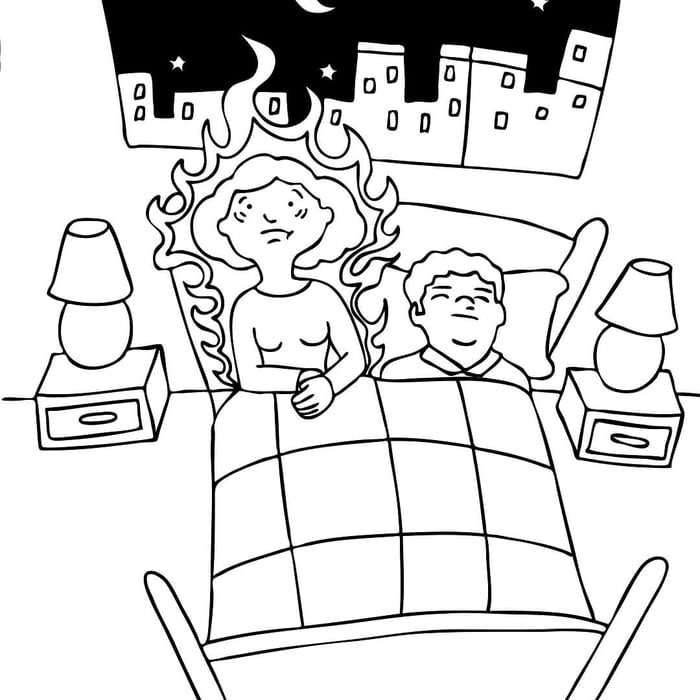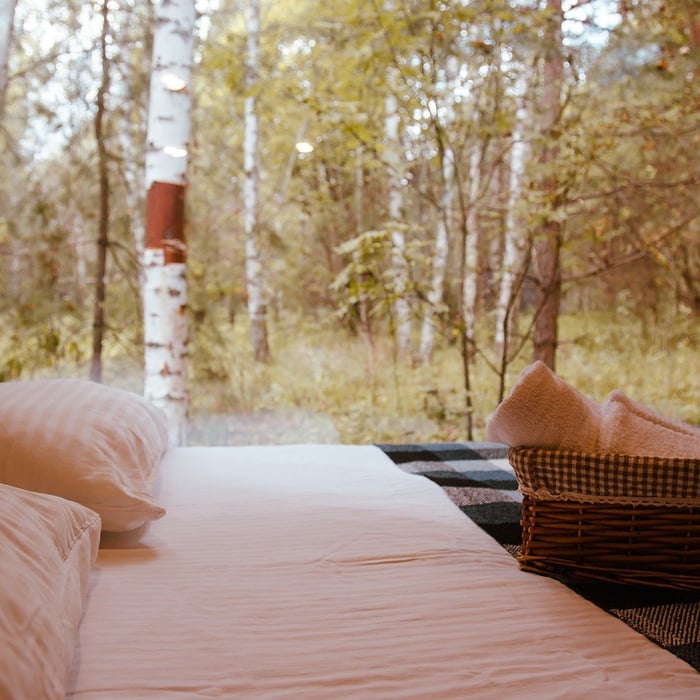Table of Contents
- If you’re Googling cooling sheets, breathable bed sheets, or cooling bedding for night sweats, you’re not alone.
- What Cooling Sheets Are — and Why They Don’t Solve Overheating
- The Science of “Cooling Sheets”: Airflow Without Temperature Regulation
- The Real Cause of Overheating: Trapped Humidity Around Your Body
- Why Wool Is the Most Breathable Bedding Material (Explained Simply)
- Wool vs Cotton, Bamboo & Synthetics for Hot Sleepers
- Why Wool Comforters Beat Cooling Sheets, Cooling Comforters & Cooling Duvet Inserts
- The Ideal Cooling Sleep Setup for Hot Sleepers
- When You Should Stop Buying Cooling Sheets (and What to Buy Instead)
- Closing Summary
- FAQs on Wool Duvet Inserts, Comforters & Sustainable Bedding
If you’re Googling cooling sheets, breathable bed sheets, or cooling bedding for night sweats, you’re not alone.
In fact, "cooling sheets" in particular is one of the highest-searched bedding terms in the world — because people everywhere are battling the same problem:
They keep waking up hot, sweaty, and uncomfortable.
But here’s the twist most people never see coming:
Cooling sheets don’t actually cool you.
At best, they provide surface-level airflow.
At worst, they trap humidity and make overheating more likely.
If you want to stay cool all night, you don’t need “cooling” fabric.
You need true temperature regulation — and only one material does that naturally:
👉 Regenerative New Zealand Wool.
Let’s break it down simply.
What Cooling Sheets Are — and Why They Don’t Solve Overheating
Searches like cooling sheets for hot sleepers and cooling sheets for night sweats exploded because people think the right sheet fabric will fix overheating.
But here’s what cooling sheets actually offer:
They improve surface airflow.
That’s it.
Cotton percale, linen, and bamboo all allow a breeze to move across your skin.
They do NOT regulate heat.
Sheets cannot:
manage humidity
remove moisture vapor
stabilize your core temperature
prevent night sweats
keep your bedding dry
And they don’t stop the cycle that wakes you up sweaty at 2 a.m.:
Heat → humidity → sweat → clammy fabric → wake-up moment
Cooling sheets can’t break that loop.
But wool can.
Sustainable & Regenerative Bedding Bundle | No More Night Sweats, Just Deeper Sleep
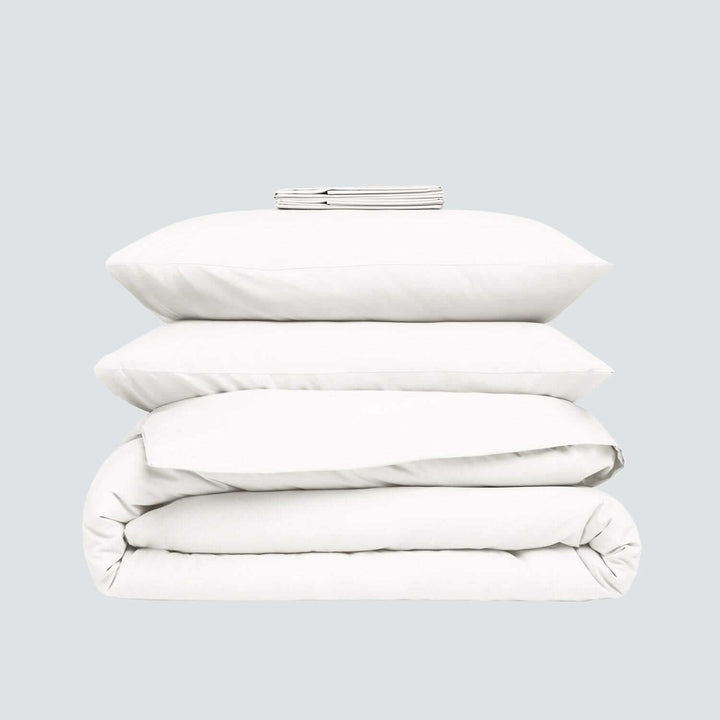
$598.40
$748.00
Cooler Nights & Deeper Sleep — Every Night Upgrade your rest with the only sustainable bundle designed with regenerative New Zealand wool and organic cotton for all-season comfort. This eco-friendly combo is made to naturally wick away heat and moisture,… Read more
The Science of “Cooling Sheets”: Airflow Without Temperature Regulation
Let’s quickly look at the most common cooling sheet fabrics:
Cotton (Percale)
Breathable on the surface.
But once you sweat, it soaks and sticks.
Linen
Great airflow.
But its thick, textured fibers hold onto moisture and warm up over time.
Bamboo (Viscose/Rayon)
Marketed as cooling.
But it’s produced like a synthetic and traps humidity inside the fibers.
“Cool-to-touch” synthetics
They feel cold for the first 10 minutes.
Then they seal heat in like plastic.
All these materials breathe… until moisture enters the picture.
Which brings us to the real reason cooling sheets stop working.
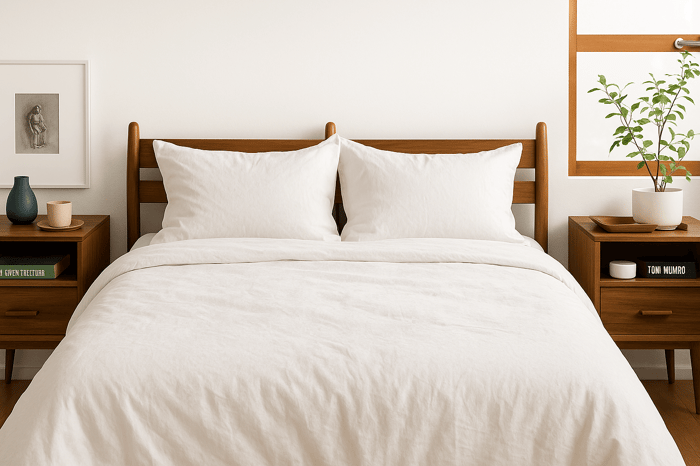 Even the best cooling sheets lose effectiveness when heat and humidity build up — natural breathable fabrics handle moisture far better.
Even the best cooling sheets lose effectiveness when heat and humidity build up — natural breathable fabrics handle moisture far better.The Real Cause of Overheating: Trapped Humidity Around Your Body
You don’t overheat because of temperature alone.
You overheat because of humidity trapped in your microclimate — the small bubble of air between your skin and your bedding.
When humidity builds up, your body works harder to cool itself → you sweat → your sheets get damp → airflow collapses → overheating intensifies.
This is why night sweats feel so miserable:
You’re stuck in your own humidity loop.
And this is where wool breaks every rule — in your favor.
Why Wool Is the Most Breathable Bedding Material (Explained Simply)
Forget everything you think you know about wool.
Modern regenerative Merino wool is the single most breathable, cooling-capable, temperature-regulating fiber on earth.
And here’s why:
1. Natural Crimp = Continuous Airflow
Wool fibers aren’t flat like cotton or bamboo.
They’re naturally springy and curled, creating thousands of tiny air pockets.
This means:
airflow circulates continuously
heat escapes before it builds
your microclimate stays balanced
Even when you lie on it — wool keeps breathing.
2. Wool Absorbs Moisture Vapor Before You Sweat
This is where wool destroys every “cooling sheet” fabric.
Wool doesn’t wait for you to sweat.
It absorbs 30–35% of its weight in vapor (not liquid!) and releases it back into the air.
This prevents:
trapped humidity
clammy skin
sweat spikes
damp sheets
heat crashes
This process is called Moisture Vapor Transfer — and wool is the world champion.
3. Wool Regulates Temperature Dynamically
It doesn’t “cool you down.”
It keeps you within your ideal temperature range, all night long.
When you get warm → it releases heat.
When you cool down → it insulates lightly.
This is true, natural temperature regulation — the kind your body is designed for.
Sheets cannot do this.
Down cannot do this.
Bamboo cannot do this.
Synthetic “cooling comforters” definitely cannot do this.
Only wool does.
Wool vs Cotton, Bamboo & Synthetics for Hot Sleepers
A simple breakdown:
| Feature | Cotton | Bamboo | Linen | Synthetics | Wool |
|---|---|---|---|---|---|
| Breathability | Good | Good | Good | Poor | Excellent |
| Moisture Absorption | Good (liquid) | Medium | Medium | Terrible | Excellent (vapor) |
| Airflow Under Pressure | Low | Low | Low | None | High |
| Humidity Control | None | Low | Low | None | Exceptional |
| Best for Night Sweats | No | No | Not ideal | NO | YES |
| Temperature Regulation | None | None | None | None | Yes — dynamic |
Nothing else comes close.
Why Wool Comforters Beat Cooling Sheets, Cooling Comforters & Cooling Duvet Inserts
A lot of people search for:
cooling comforters
cooling duvet insert
breathable comforters
But here’s the thing:
Most “cooling comforters” are polyester blends.
They breathe for 20 minutes… then trap humidity the rest of the night.
Your organic regenerative wool comforter does what they can’t:
✔ Keeps airflow moving
✔ Absorbs and releases vapor
✔ Regulates temperature
✔ Prevents humidity buildup
✔ Stays dry to the touch
✔ Supports deeper sleep cycles
It’s a complete sleep system, not a single-layer trick.
Organic Wool Comforter | Made in New Zealand, Breathable All-Season Comfort
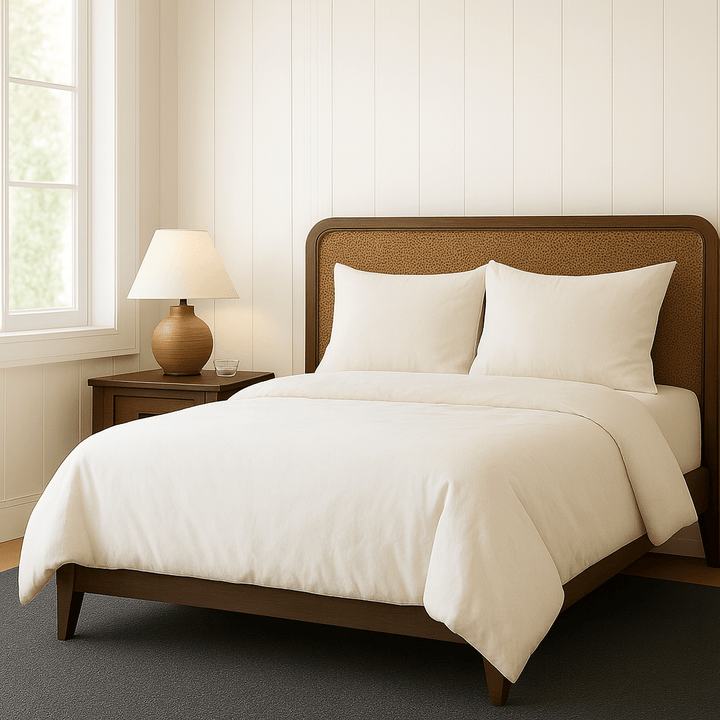
$342.00
$380.00
Sleep naturally better with our organic wool comforter Unlike down or synthetic comforters that trap heat, this lightweight wool design wicks away moisture and prevents overheating, so you stay cool, dry, and deeply relaxed. It’s comfort that feels effortless yet… Read more
The Ideal Cooling Sleep Setup for Hot Sleepers
If you want cooler nights, you need a system — not just sheets.
1. Wool Comforter
The engine of temperature regulation.
2. Organic Cotton Sheets
Soft, breathable, non-toxic, and the perfect complement to wool.
3. Minimal Layering
Let the wool microclimate do its job.
4. Balanced Room Humidity
A dry room = less sweating = deeper sleep.
This setup is the sweet spot for:
hot sleepers
menopause night sweats
couples with different temps
desert climates (Scottsdale)
humid climates
anyone who “wakes up sweaty” regularly
When You Should Stop Buying Cooling Sheets (and What to Buy Instead)
You should move beyond cooling sheets if:
you still wake up sweaty
you run hot no matter the season
your sheets feel damp after a few hours
you kick off the blankets at night
your partner sleeps warmer or colder than you
you’ve tried bamboo, cotton, linen… and nothing works
The problem isn’t the sheets.
It’s that sheets can’t regulate temperature.
Wool can.
Regenerative Organic Cotton Sheet Set – Soft, Breathable & Sustainable

$189.00
Softer Sheets. Cleaner Sleep. Our organic cotton sheet set are simply better for the earth, and for your sleep. Grown on low-impact regenerative farms that actively heal the soil, our cotton is then woven and finished responsibly. This process eliminates… Read more
Closing Summary
Cooling sheets offer airflow.
They feel crisp. They feel light.
But they don’t solve the real reason you overheat: trapped humidity.
If you truly want to sleep cooler — not just for the first hour, but all night — the answer is simple:
👉 Choose the material nature designed for thermoregulation: Regenerative New Zealand Wool.
It’s breathable.
It’s moisture-regulating.
It’s temperature-balancing.
And it delivers naturally deeper, more restorative sleep.
Cooler nights. Brighter mornings.
That’s the power of a wool comforter.
Explore Our Bedding For Hot Sleepers Collection
FAQs on Wool Duvet Inserts, Comforters & Sustainable Bedding
Do cooling sheets actually keep you cool?
Not in the way most people hope. Cooling sheets improve surface airflow, which makes them feel crisp at first. But they can’t regulate temperature or humidity — the real drivers of overheating. Once moisture builds up under your bedding, airflow collapses and the sheets trap heat. Only materials that manage moisture vapor, like wool, can prevent that cycle.
Why do cooling sheets stop feeling cool after a few hours?
Because “cooling” fabrics like cotton, linen, and bamboo absorb liquid moisture, not vapor. Once they soak up humidity from your body, the fibers get heavier, cling to your skin, and stop letting air circulate. That’s why you feel cool at bedtime but wake up sweaty around 2 a.m. Wool handles vapor before sweat ever forms — so airflow never shuts off.
Are cooling sheets good for night sweats?
They can help at the start of the night, but they don’t fix the underlying issue: humidity trapped around your body. Night sweats are caused by moisture and temperature swings, and cooling sheets can’t manage either. Wool absorbs vapor, releases it back into the air, and keeps the microclimate dry — which is why wool bedding outperforms all “cooling” fabrics for night sweats.
What is the most breathable bedding material for hot sleepers?
Wool. Its natural crimp creates tiny air pockets that circulate heat away from your body, even under pressure. Cotton and bamboo only breathe when they’re dry — once damp, they collapse. Wool keeps airflow moving all night, which makes it the most breathable bedding material for hot sleepers by a long stretch.
What bedding keeps you coolest at night?
A temperature-regulating system, not a single fabric. The most effective setup is:
A wool comforter for airflow + moisture vapor transfer
Organic cotton sheets for breathable softness
Minimal layering so your body can regulate naturally
Cooling sheets alone won’t keep you cool long-term, but this system will.
Are wool comforters too warm for hot sleepers?
This is the biggest misconception about wool. Modern Merino wool isn’t heavy or suffocating — it’s naturally climate-adaptive. Wool releases heat when you warm up and gently insulates when you cool down. That’s why hot sleepers often find they sleep cooler under wool than under cotton, bamboo, down, or synthetics.
How does wool prevent overheating?
Wool manages vapor, not sweat. Before your body starts producing liquid moisture, wool absorbs humidity from the microclimate and releases it back into the air. This prevents heat spikes, sweat cycles, and moisture buildup — the root causes of nighttime overheating. It’s a built-in climate control system.
Are bamboo or Tencel sheets better than wool for cooling?
They’re breathable when dry, but they don’t handle humidity well. Bamboo and Tencel absorb water fast, which makes them feel damp and clingy. They also trap humidity inside the fibers. Wool stays dry to the touch and moves vapor continuously — which is why wool outperforms bamboo and Tencel in every hot-sleeper test.
What’s the best comforter for hot sleepers?
A wool comforter — specifically one made with regenerative Merino wool. Wool keeps air moving, prevents humidity buildup, and naturally adjusts to your body temperature. Cotton, bamboo, down, and synthetic “cooling” comforters can’t regulate temperature the same way because they don’t manage vapor.
How can I cool down my bed without relying on cooling sheets?
Try these natural fixes:
Switch to a wool comforter to regulate heat and humidity
Use organic cotton sheets for breathable softness
Reduce layers (simple is better for airflow)
Keep bedroom humidity between 40–55%
Avoid synthetic bedding — it traps heat
These steps address the real cause of overheating instead of masking it.


